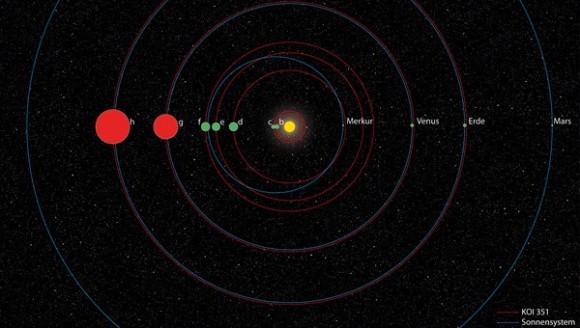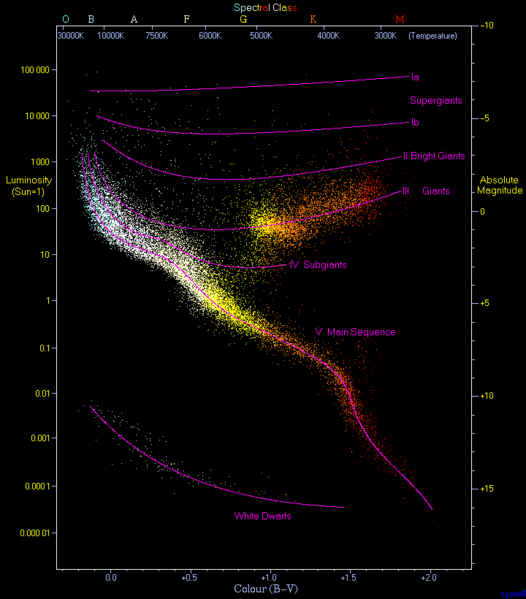Science
Related: About this forumSecond Planetary System Like Ours Discovered

A comparison between our solar system and a second planetary system: KOI-351.
A team of European astronomers has discovered a second planetary system, the closest parallel to our own solar system yet found. It includes seven exoplanets orbiting a star with the small rocky planets close to their host star and the gas giant planets further away. The system was hidden within the wealth of data from the Kepler Space Telescope.
KOI-351 is “the first system with a significant number of planets (not just two or three, where random fluctuations can play a role) that shows a clear hierarchy like the solar system — with small, probably rocky, planets in the interior and gas giants in the (exterior),” Dr. Juan Cabrera, of the Institute of Planetary Research at the German Aerospace Center, told Universe Today.
Three of the seven planets orbiting KOI-351 were detected earlier this year, and have periods of 59, 210 and 331 days — similar to the periods of Mercury, Venus and Earth.
But the orbital periods of these planets vary by as much as 25.7 hours. This is the highest variation detected in an exoplanet’s orbital period so far, hinting that there are more planets than meets the eye.
Read more: http://www.universetoday.com/106759/second-solar-system-like-ours-discovered/
Iliyah
(25,111 posts)I'm pretty sure there are countless planets like ours with creatures probably a hell of a lot advanced than earth.
Moostache
(9,895 posts)It is POSSIBLE that humanity is the current apex of universal evolution...
It is equally PROBABLY that there are millions of opportunities existing in the universe right now...
We just might be the very first to achieve what little we have (relative to our potential that is) and there just might not be any other sentient lifeforms out there.
Or there may be millions of civilizations and countless species more advanced than us; but we may all remain perpetually separated by the speed of light and distances too vast to cross and technologically impassable.
I really don't know which scenario I like less to be honest. The idea of having other species in other galaxies that might have been through this kind of madness that we have on Earth - where we are actively killing not just each other in wars and through exploitation but also killing the planet because of greed and "profit margins" - has always seemed comforting in a way.
I don't see myself as just part of life on this planet, but as part of LIFE in a general sense. I derive meaning from my existence in understanding that my actions while I hold my current form must make an impact on advancing the possibilities for LIFE (in the abstract, not in the daily form it has on this planet) to continue, to thrive, to go on after I have left the stage. This sustains me better than anything else I have encountered on Earth, but it also makes me sad to see so few others share in such an outlook.
Maybe there are others out there, and maybe there is no one else. Maybe civilizations with immense and incomprehensible wisdom are out there somewhere, but maybe we are the first ones to develop long enough and with enough technology to reach the infancy of possibility.
I don't know, but it sure is fun to consider the probabilities and possibilities!
I see the spectral type is "Late F/Early G," so we'll have to investigate closer. As such, the Earth-analog is somewhere between somewhat warm comparatively and extremely hot.
calimary
(81,222 posts)Glad you're here!
Curious to see all the snarky comments at the end of this story.
"WOW! And if we leave right away in a ship going 67 million miles per hour, we'll be there in a short 25,000 years! Why do they continue to report this crap?"
Sheesh - can't they let their imagination run with even just the idea?
![]()
![]()
![]()
longship
(40,416 posts)Which means the star's life will be shorter than Sol.
For those who don't know, the stellar classes are O B A F G K M, with O being the largest, hottest, most massive and M being the smallest, coolest, least massive. The more massive a star, the shorter it lives as it burns through its fuel faster. Sol is rated as a G class (G3).
Earth will become uninhabitable in about another billion years as Sol gets too hot to handle, so to speak. All M class stars ever born are still burning, albeit dimly and will continue doing for another trillion years or so.
AFAIK.
Diclotican
(5,095 posts)longship
Or as I once learned it O Be A Nice Girl Kiss Me ![]()
Diclotican
longship
(40,416 posts)I learned the Hertzsprung-Russell Diagram in Astronomy 101. Of course, it shows the spectral classes graphically. (For non-astronomy people.)

The mass-luminosity relationship is seen as the somewhat diagonal band from upper-left to lower-right. Of course, as one goes to lower masses the number of stars in each class gets more numerous because lower mass means longer lifetimes.
Diclotican
(5,095 posts)longship
I have to admit - I have for the most part been "self-learned" and read a lot of books - way ahead of my age - when I was a kid I was fascinated by the universe - and I would say one of them, who influent my imagination was Carl Sagan - and Cosmos, the series - and the book, who still is in my book shelf by the way even if the book itself is old and most of the information outdated by now... Stewen Hawking have also influenced me, even thought I have to admit - most of his writings is way over my head...
But for some reason I have remembered Herzelsprung-Russel diagram - specially when it comes to the main star class - and specially the rime - O Be A Fine Girl Kiss Me have stuck to me...
The Universe is amazing, just what our systems have managed to discover the last decade or so is just amazing to be honest - and even still - most of it are not even discovered - I are just waiting for the first news about a solar system - who might as well resemble our own - out there in our nabourhood.... As our technology is making progress - so does the possibility of discovering a small rocky planet - who resemble our own.. And it might also be the discovery that we are not alone in the universe - maybe we have "families" out there - who struggle as we do - making progress to something better...
Diclotican
longship
(40,416 posts)Warpy
(111,254 posts)because all 3 planets are within Mercury's orbit and the weather would be lousy, otherwise, unless you thrive in lava with no atmosphere to speak of.
I still think the planets most likely to have life as we know it will orbit gas giants relatively close to their stars. Binary planetary systems like the Earth and Moon are probably rare.
Spitfire of ATJ
(32,723 posts)tavernier
(12,382 posts)But none of them are dancing.
![]()